Showing top 0 results 0 results found
Showing top 0 results 0 results found

Are you looking to enhance your customer service experience with a chatbot in 2024?
With 74% of internet users preferring chatbots for straightforward questions, it's clear that these AI-driven assistants are not just a trend but a cornerstone of modern customer interaction strategies.
Chatbots offer a unique blend of efficiency, accessibility, and automation, making them an invaluable tool for businesses aiming to stay at the forefront of customer service technology.
This guide covers key chatbot design tips, best practices, and examples to create an engaging and effective chatbot. We'll discuss defining your chatbot's purpose, choosing the right type, optimizing the UI, ensuring smooth transitions to human support, and what to avoid for a successful chatbot setup.
Whether introducing a chatbot or looking to refine your existing chatbot strategy, this article will provide you with the insights you need to make informed decisions and create a chatbot experience that resonates with your users in 2024.
What are chatbots?
Chatbots, enhanced by AI, are designed to simulate human-like conversations with users, increasingly utilizing natural language processing (NLP) to provide personalized and efficient responses. They have transitioned from straightforward rule-based systems to complex AI platforms, offering immediate and accurate assistance for a wide range of customer inquiries 24/7.
In 2023, chatbots across various platforms conducted 134,565,694 chats, highlighting this technology's widespread adoption and effectiveness.
ChatBot exemplifies this evolution with its no-coding, secure platform for creating AI chatbots, streamlining deployment, and enhancing user experience without relying on third-party AI providers.
🤖 Never heard of ChatBot before?
What is chatbot design?
Chatbot design combines UX/UI design, conversational AI, machine learning, and copywriting to craft effective chatbot interactions. Understanding user needs and business processes ensures chatbots deliver seamless communication and positive business outcomes.
ChatBot's platform demonstrates this by offering an intuitive, no-code setup that democratizes conversational AI, enabling businesses to create chatbots that are both user-friendly and aligned with business objectives, thus providing exceptional support and maintaining data security internally.
Chatbot design: 13 tips and best practices
Designing a chatbot requires thoughtful consideration and strategic planning to ensure it meets the intended goals and delivers a seamless user experience.
Here are some crucial tips and best practices to guide you through the process:
1. Clarify your chatbot's purpose
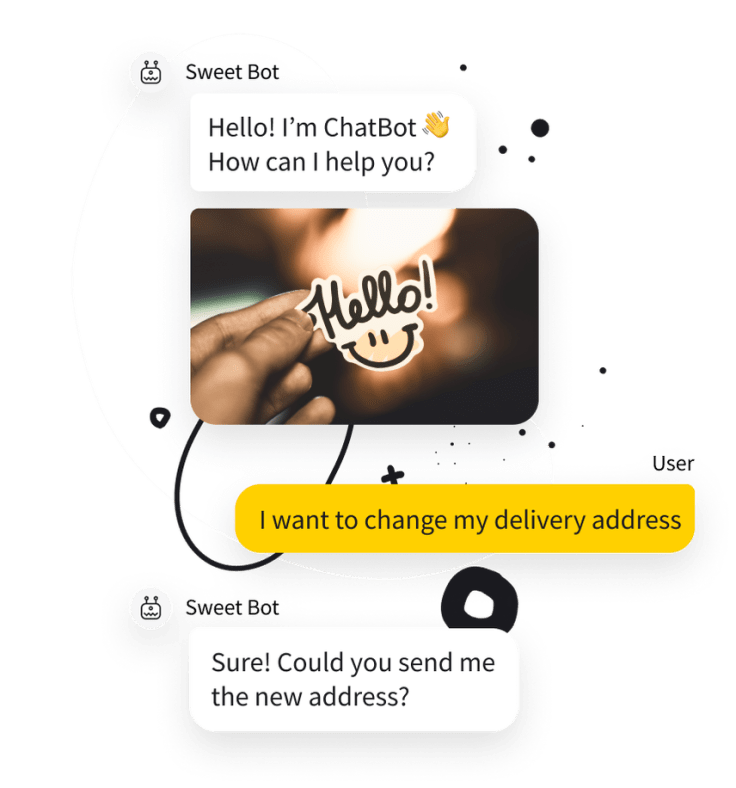
Understanding the purpose of your chatbot is the foundation of its design. It's vital to ask yourself why you're integrating a chatbot into your service offering.
A chatbot should be more than a novel feature; it should serve a specific function that aligns with your business objectives and enhances user experience. Whether it's to provide immediate customer support, answer frequently asked questions, or guide users through a purchase process, the purpose of your chatbot must be clear and focused.
A well-defined goal not only influences the development of your chatbot technology but also ensures every interaction through graphical user interfaces or messaging apps adds value to the user's experience. By pinpointing the exact challenges and tasks your chatbot will address, you can tailor its capabilities to meet those needs effectively. This strategic approach optimizes the chatbot's utility and aligns it more closely with your business goals, leading to a more effective and efficient deployment.
It is crucial to incorporate a thorough understanding of your business challenges and customer needs into the chatbot design process. This ensures that the chatbot meets your users' immediate requirements while supporting your long-term business strategies.
ChatBot, for example, leverages its platform to provide practical solutions that align with the business's overarching objectives, ensuring that the chatbot delivers meaningful and impactful interactions.
2. Select the right type of chatbot
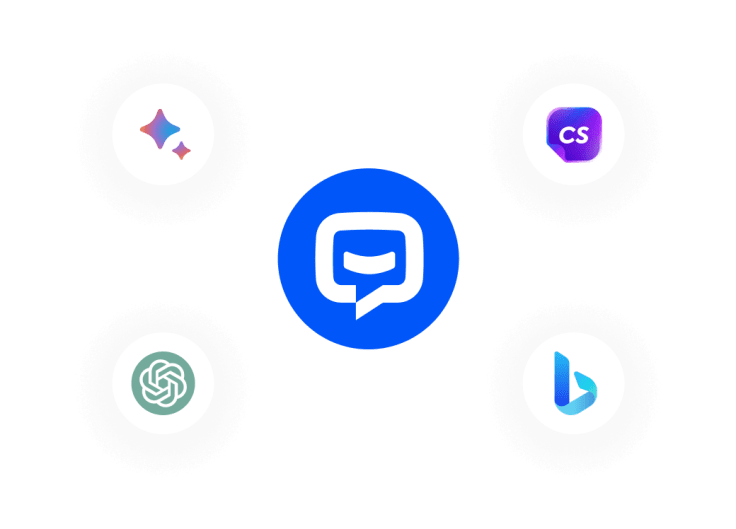
Selecting the right chatbot platform and type, such as an AI chatbot, is critical in ensuring its effectiveness for your business. The distinction between rule-based and NLP chatbots significantly impacts how they interact with users.
Rule-based chatbots operate on predefined pathways, guiding users through a structured conversation based on anticipated inputs and responses. These are ideal for straightforward tasks where the user's needs can be easily categorized and addressed through a set series of options.
On the other hand, NLP chatbots offer a more dynamic and flexible interaction style. They understand and process user inputs in a more human-like manner, making them suitable for handling complex queries and providing personalized responses. By learning from interactions, NLP chatbots continually improve, offering more accurate and contextually relevant responses over time.
For businesses looking for an immediate solution to manage customer inquiries or to support a limited customer service team, an NLP chatbot can be a more suitable option. It requires no coding for setup and can integrate a comprehensive knowledge base to provide accurate responses quickly. This adaptability makes it a valuable tool for businesses aiming to enhance their customer service experience without the extensive resource investment required for traditional support channels.
3. Understand your platform's capabilities and limitations
Selecting the right development platform is critical in creating an effective chatbot. It's essential to choose a platform that not only aligns with your chatbot's intended purpose and complexity but also offers the flexibility and functionality you need. Each platform has its unique strengths and limitations, and understanding these will enable you to optimize your chatbot design to its full potential.
For instance, some platforms may offer robust rule-based conversation models but lack the ability to craft unique, dynamic responses to unexpected user queries. This limitation could restrict the versatility of your chatbot in handling more nuanced interactions. On the other hand, platforms that allow for more sophisticated input, such as those utilizing NLP technologies, may require a deeper understanding of coding to fully exploit their capabilities.
The ideal platform balances ease of use with powerful features, enabling you to deploy an intelligent chatbot without extensive technical support. Look for a platform that simplifies the creation and management of your chatbot, such as ChatBot, which allows for quick setup and customization through user-friendly interfaces. This approach ensures that your chatbot can be both sophisticated in its functionality and straightforward in its deployment, making it accessible to businesses of all sizes.
4. Define personality and tone
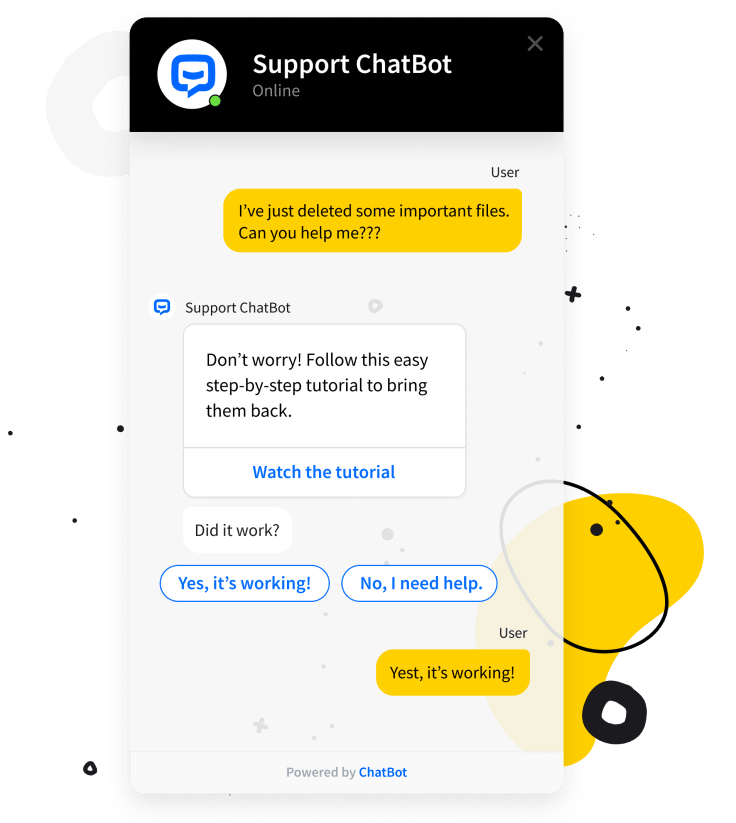
Your chatbot's character and manner of communication significantly influence user engagement and perception. Crafting your chatbot's identity to mirror your brand's essence boosts engagement and fosters a deeper connection with users. It goes beyond mere dialogue, focusing on the style and approach of interaction.
By leveraging screenwriting methods, you can design a distinct personality for your Facebook Messenger chatbot, making every interaction functional, engaging, and memorable. The chatbot name should complement its personality, enhancing relatability.
Aligning your chatbot's demeanor with your brand's ethos is crucial. Some brands may find a humorous and witty chatbot aligns well with their identity, while others may opt for a more direct, helpful, and courteous approach. The objective is to create a chatbot experience that feels intuitive and is in harmony with the user's expectations and your brand's narrative.
However, it's essential to recognize that 48% of individuals value a chatbot's problem-solving efficiency above its personality. This statistic underlines the importance of balancing a compelling personality with the chatbot's effectiveness in addressing user needs, ensuring that the chatbot delivers practical value in every interaction.
5. Design intuitive user flows and conversations
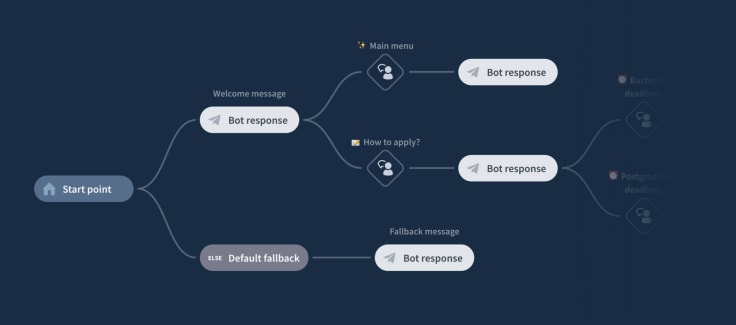
Creating intuitive user flows and conversations is crucial for a seamless chatbot experience. By mapping out user flows that mirror typical interaction patterns, you can design straightforward, relevant, and genuinely helpful conversations. This planning phase is instrumental in anticipating user needs and providing clear pathways for task completion.
Ensuring that conversations with the chatbot, especially when integrated into messaging apps, feel natural is paramount. Each interaction should smoothly guide users toward their objectives, allowing for questions and additional input along the way. This approach makes the chatbot more user-friendly and more effective in achieving its purpose.
Moreover, mapping out conversations helps identify potential sticking points where users might need additional support. This insight is invaluable for continuous improvement, allowing you to refine interactions, introduce new features, and tailor messages based on user feedback. The goal is to create a chatbot that meets users' immediate needs and evolves with them, enhancing the overall customer experience.
6. Optimize the chatbot UI for user-friendliness

A chatbot's user interface (UI) is as crucial as its conversational abilities. An intuitive, visually appealing UI enhances the user experience, making interactions efficient and enjoyable. To achieve this, careful consideration must be given to the choice of fonts, color schemes, and the overall layout of the chatbot interface. These elements should be designed to ensure readability and ease of navigation for all users, including those with visual impairments.
Incorporating support for visual aids and ensuring compatibility with screen readers are essential steps in making your chatbot accessible to a wider audience. This inclusivity broadens the potential user base and reflects positively on your brand's commitment to accommodating diverse needs.
Furthermore, the chatbot UI should be designed to be responsive across different devices and platforms, providing a consistent and seamless experience regardless of how users choose to interact with it.
7. Disclose the chatbot's nature
Transparency is key in building trust and setting realistic expectations with users. It's important to clearly disclose that users are interacting with a chatbot right from the start. This honesty helps manage users' expectations regarding the type of support and responses they can anticipate. Acknowledging the chatbot's automated nature reassures users that while their interactions may not be with a human, the designed system is capable and efficient in addressing their needs.
This transparency fosters trust while preparing users for the type of interaction they can expect, minimizing potential frustration. It's a practice that encourages a more forgiving and understanding user attitude towards limitations the chatbot might have. By setting clear expectations, users are more likely to appreciate the chatbot's assistance and less likely to be disappointed by the lack of human touch in responses.
8. Plan for misunderstandings and errors
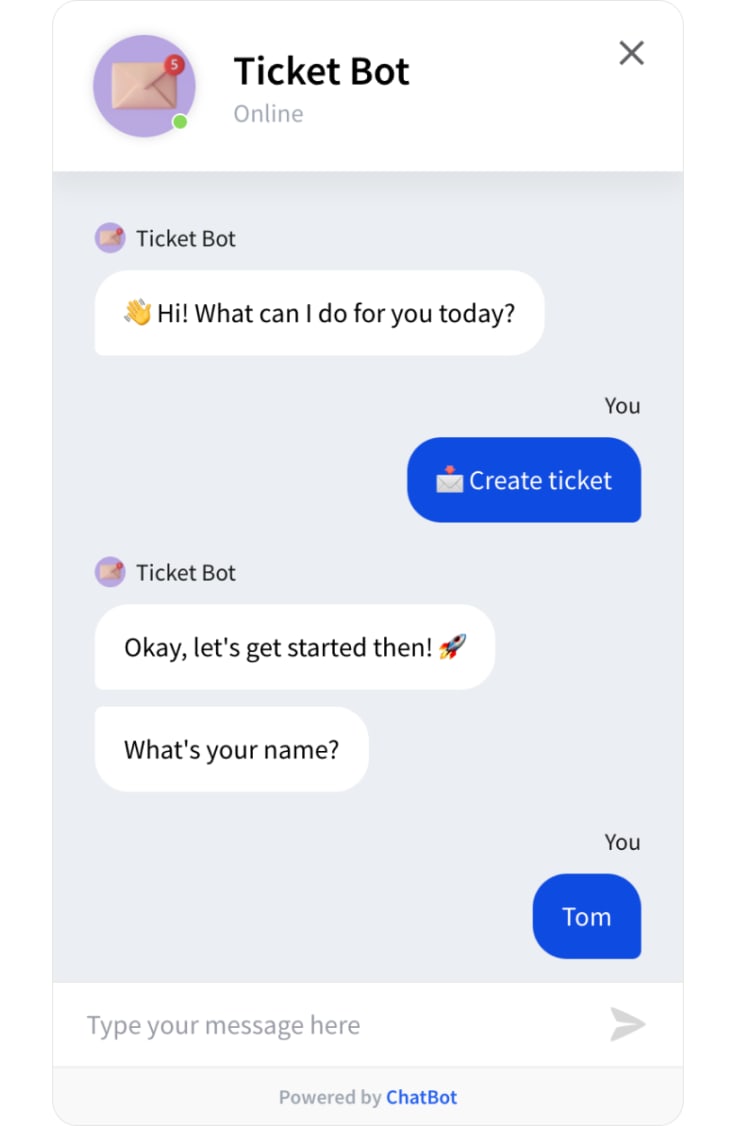
Despite advancements in chatbot technologies, misunderstandings and errors are inevitable. Therefore, it is crucial to design chatbots that can handle these situations gracefully. Creating a chatbot that can offer clarifications, suggestions, or the option to restart the conversation can significantly improve the user experience during misunderstandings.
Designing for error handling involves preparing for the unexpected. Implementing creative fallback scenarios ensures that the chatbot remains helpful and engaging, even when it cannot fully understand or fulfill the user's request. This approach includes crafting error messages and responses in plain language to avoid confusion and ensuring that the chatbot can effectively guide users to the main conversation flow.
Moreover, introducing variety in the chatbot's responses to misunderstandings can mimic the dynamics of a human conversation, making the interaction feel more natural and less repetitive. Providing users with alternative options or buttons to choose from when the chatbot cannot proceed as expected helps maintain engagement and guides users smoothly back into the productive interaction pathways.
9. Incorporate visuals
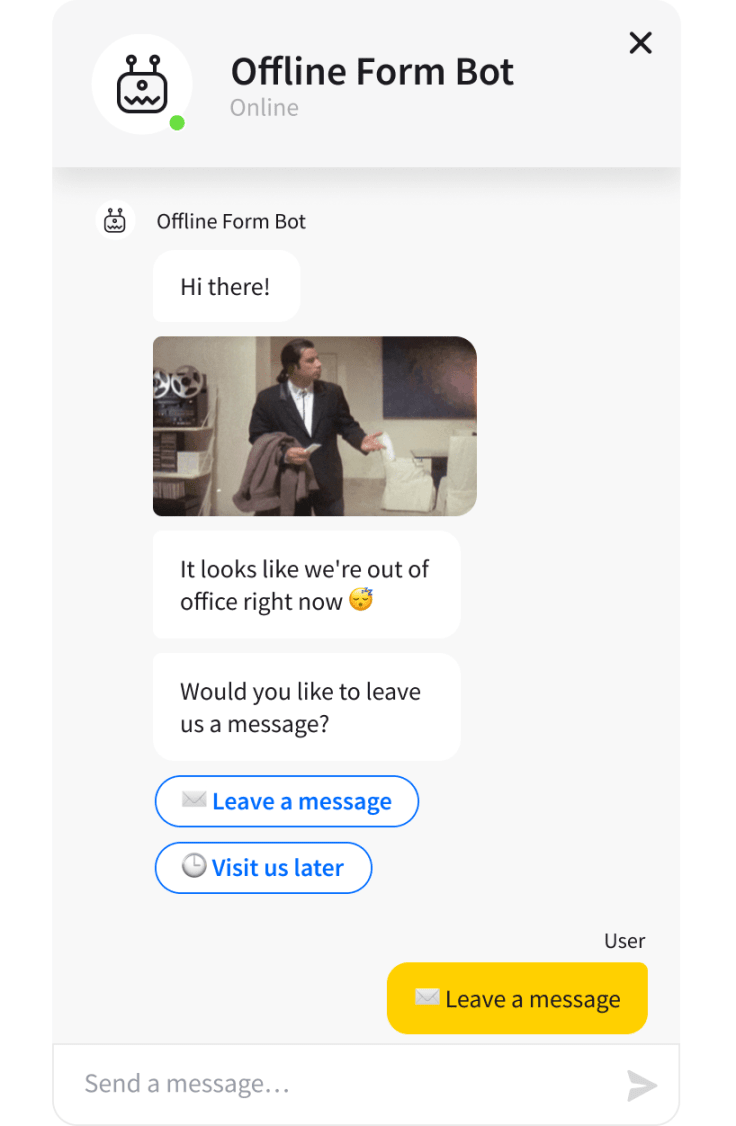
Enhancing chatbot interactions with visuals such as images, videos, and multimedia elements significantly boosts user engagement and comprehension. Research highlights the human brain's capacity to process visuals much faster than text, suggesting that incorporating visual content can more effectively capture and retain user attention.
For instance, a chatbot could display images of products, maps to locate stores, or even videos demonstrating how to use a service or product. This not only makes the interaction more informative but also more enjoyable.
Utilizing visuals creatively can also add a layer of personality to chatbot conversations. Humorous gifs or playful images can lighten the mood and make the experience more memorable for users. Furthermore, visual elements like brand logos, icons, and carousels can guide users through your website, seamlessly integrating with the chatbot's conversational flow. This visual guidance aids users in exploring products, services, and FAQs more efficiently, enhancing the overall user experience.
Providing documents directly through chat interactions represents another valuable use of visuals and multimedia. By enabling chatbots to send important documents, such as shipping labels or registration confirmations, the process becomes smoother for the user, eliminating the need for additional steps or human agent intervention. This feature underscores the versatility and utility of integrating visual elements into chatbot designs, making them engaging and functionally comprehensive.
10. Educate users on how to interact with your chatbot
Optimizing the user's experience with your chatbot starts with proper education on how to interact effectively. Clear, upfront instructions on using specific commands or phrases can significantly enhance the efficiency of the interaction. For instance, informing users about the types of inquiries the chatbot can handle or suggesting keywords and phrases for quicker resolutions can streamline the conversation and lead to faster solutions.
During periods of inactivity or silence in the conversation, the chatbot can proactively offer tips or display button options for common requests, guiding users through their journey. This aids in maintaining the flow of the interaction and educates users on utilizing the chatbot more effectively in future interactions.
Such strategies improve the immediate experience and empower users by making them more familiar with the chatbot's capabilities. By educating users on the most efficient ways to communicate with the chatbot, businesses can ensure that their customers get the most out of their interactions, leading to higher satisfaction and better engagement.
🤖 Would you like to grow your business with AI?
11. Balance proactive and reactive interactions
Finding the right balance between proactive and reactive interactions is crucial for maintaining a helpful chatbot without being intrusive. Proactive interactions, such as greeting users with offers or information based on their browsing behavior, can enhance the user experience by providing value at just the right moment. For example, a chatbot might offer a discount code after noticing a user has been viewing a product for a certain period, making the interaction feel personalized and timely.
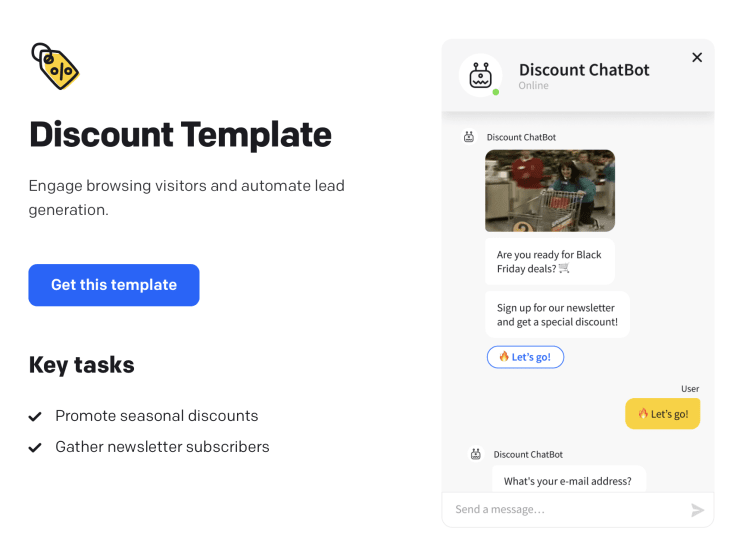
However, it's important to ensure that these proactive prompts are delivered in a way that considers the user's experience, typically by placing them in non-intrusive areas of the screen. This strategic placement ensures that the chatbot's messages are noticed without overwhelming the user, adhering to best practices in chatbot UX design.
Moreover, the content of these messages should be carefully considered to ensure relevancy and value. While recommending related products or services can be helpful, bombarding users with unrelated offers can be off-putting. Tailoring suggestions to fit the user's current needs and interests, such as recommending accessories for a recently viewed product, can enhance the user experience by providing genuinely useful information. This thoughtful approach to balancing proactive and reactive chatbot interactions fosters a more engaging and satisfying user experience.
12. Ensure easy transition to human support
Integrating an easy option for users to escalate their inquiries to human support is crucial for maintaining high levels of customer satisfaction. Despite the efficiency and availability of chatbots, there are situations where the need for human empathy, understanding, and decision-making is irreplaceable, especially in handling complex issues or complaints. Designing your chatbot with a seamless transition mechanism to human agents ensures that users feel supported and valued throughout their interaction with your service.
This transition should be smooth and intuitive without requiring users to repeat themselves or navigate cumbersome processes. By offering a clear option within the chatbot conversation on platforms like Facebook Messenger for users to escalate their query to a human agent, you ensure a positive user experience, even if their needs exceed the chatbot's capabilities. Such a feature enhances customer support and builds trust in your brand by demonstrating a commitment to comprehensive care.
13. Use A/B testing to refine conversations

A/B testing is a powerful tool in optimizing chatbot interactions to ensure they meet user needs and preferences effectively. Testing different messages and conversation flows allows you to gather invaluable insights into what resonates most with your audience. This method involves presenting two variants of the chatbot's conversations to users and then analyzing which performs better in engagement, satisfaction, or achieving specific objectives.
Regularly employing A/B testing, informed by user research, allows for the continual refinement of your chatbot’s communication strategies on conversational interfaces. This iterative process helps identify the most effective ways to present information, interact with users, and guide them toward desired actions or outcomes. Through consistent testing and analysis, you can enhance the chatbot's effectiveness, making it a more valuable asset in your customer service and engagement toolkit.
Things to avoid during your chatbot design
While designing a chatbot, certain pitfalls can detract from user experience and efficiency. Navigating these carefully is essential to ensure your chatbot serves its intended purpose effectively and enhances user interactions.
Here are key aspects to avoid:
- Overcomplicating the conversation flow: Users appreciate simplicity and clarity. Avoid creating convoluted paths that confuse users.
- Ignoring user feedback: Continuous improvement is crucial. Neglecting user input can prevent your chatbot from evolving to better meet user needs.
- Lack of personalization: Treating all users the same can make interactions feel impersonal and generic. Avoid missing opportunities to tailor conversations to individual user preferences or history.
- Failing to set clear expectations: If users expect human-like interactions from a chatbot that can't deliver, frustration is inevitable. Be transparent about your chatbot's capabilities.
- Overusing automated responses: While automation is the chatbot's strength, relying too heavily on canned responses can make the conversation feel robotic and unsatisfactory.
- Making it hard to reach human support: Ensure users can easily escalate to human support when needed. A chatbot should facilitate, not hinder, customer service.
By steering clear of these common mistakes, you can design a chatbot that truly enhances user experience, aligns with your brand, and fulfills its intended purpose within your customer service ecosystem.
Elevate your chatbot design with ChatBot
Discover why ChatBot is the go-to platform for creating engaging, efficient, and user-friendly chatbots:
- Intuitive Visual Builder: Design sophisticated chatbots easily, no coding required.
- Advanced AI and NLP: Ensure human-like understanding and responses for natural user flows.
- Customizable templates: Kickstart your design with templates for various business needs.
- Seamless integration: Enhance user experience with easy integration and scalability.
- Robust analytics: Utilize analytics and A/B testing for continuous chatbot improvement.
- Community and support: Gain insights and support from a dedicated team and user community.
ChatBot simplifies AI chatbot development on chatbot platforms while offering advanced features, including graphical user interfaces, to meet your business's unique needs, making it the perfect choice for elevating your customer engagement strategy.
Conclusion
Designing a chatbot in 2024 requires a thoughtful blend of technological savvy, user-centric design principles, and strategic planning. By following the tips and best practices outlined in this guide, you can create a chatbot that not only meets but exceeds user expectations, driving enhanced customer satisfaction and engagement. Remember, a well-designed chatbot is more than just a tool; it's an extension of your brand's customer service philosophy.
With ChatBot, you have everything you need to craft an exceptional chatbot experience that is efficient, engaging, and seamlessly integrated into your digital ecosystem.
Start designing your chatbot today to unlock the full potential of AI-powered customer interactions in 2024 and beyond.
🤖 Do you want to offer better and faster customer support?



